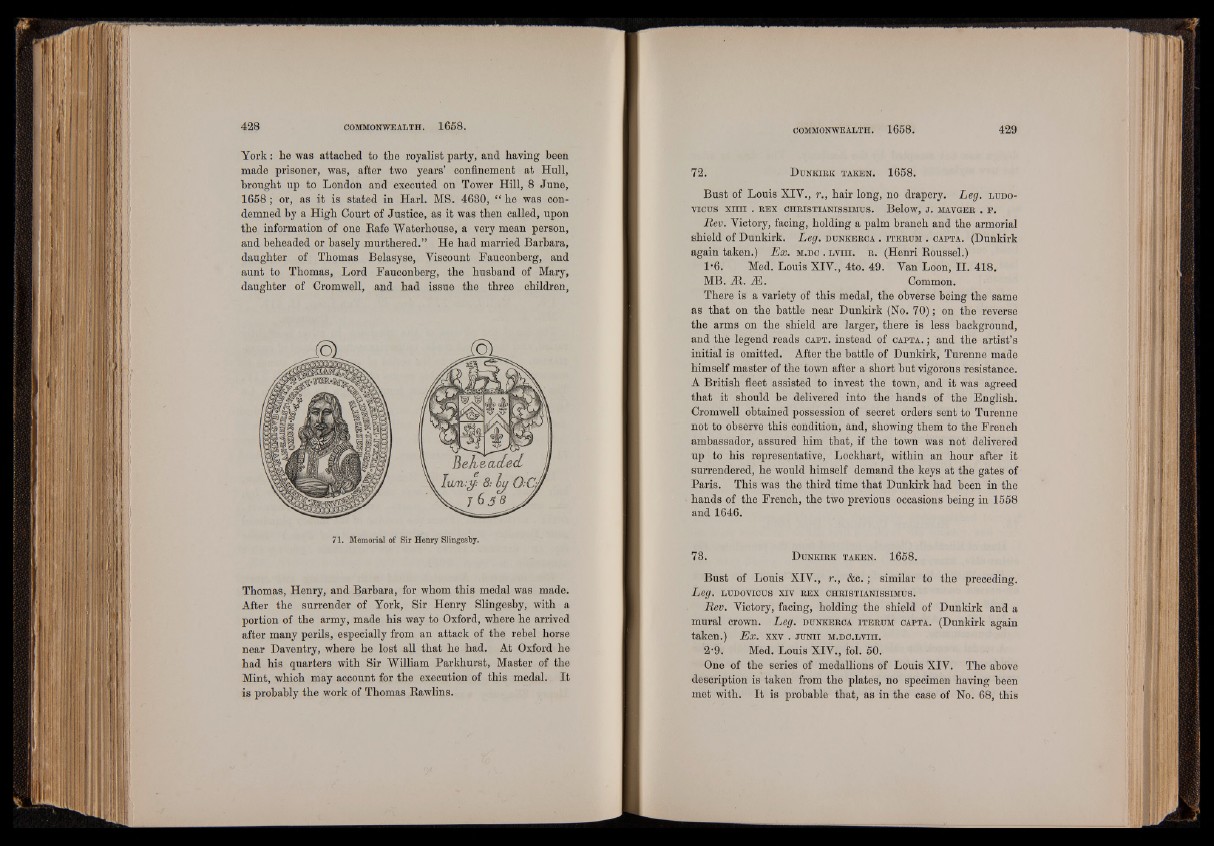
York: he was attached to the royalist party, and having been
made prisoner, was, after two years’ confinement at Hull,
brought up to London and executed on Tower Hill, 8 June,
1658; or, as it is stated in Harl. MS. 4680, “ he was condemned
by a High Court of Justice, as it was then called, upon
the information of one Rafe Waterhouse, a very mean person,
and beheaded or basely murthered.” He had married Barbara,
daughter of Thomas Belasyse, Viscount Fauconberg, and
aunt to Thomas, Lord Fauconberg, the husband of Mary,
daughter of Cromwell, and had issue the three children,
71. Memorial of Sir Henry Slingesby.
Thomas, Henry, and Barbara, for whom this medal was made.
After the surrender of York, Sir Henry Slingesby, with a
portion of the army, made his way to Oxford, where he arrived
after many perils, especially from an attack of the rebel horse
near Daventry, where he lost all that he had. At Oxford he
had his quarters with Sir William Parkhurst, Master of the
Mint, which may account for the execution of this medal. It
is probably the work of Thomas Rawlins.
72. D u n k ir k ta k e n . 1658.
Bust of Louis XIV., r . , hair long, no drapery. Leg. lu d o -
VICUS XIIII . REX CHRISTIANISSIMUS. Below, J . MAVGER . F.
Rev. Victory, facing, holding a palm branch and the armorial
shield of Dunkirk. Leg. d u n k er ca . it e r u m . capta. (Dunkirk
again taken.) Ex. m .dc . l v i i i . r . (Henri Roussel.)
l -6. Med. Louis XIV., 4to. 49. Van Loon, II. 418.
MB. At. Al. Common.
There is a variety of this medal, the obverse being the same
as that on the battle near Dunkirk (No. 70); on the reverse
the arms on the shield are larger, there is less background,
and the legend reads c a pt . instead of capta. ; and the artist’s
initial is omitted. After the battle of Dunkirk, Turenne made
himself master of the town after a short but vigorous resistance.
A British fleet assisted to invest the town, and it was agreed
that it should be delivered into the hands of the English.
Cromwell obtained possession of secret orders sent to Turenne
not to observe this condition, and, showing them to the French
ambassador, assured him that, if the town was not delivered
up to his representative, Lockhart, within an hour after it
surrendered, he would himself demand the keys at the gates of
Paris. This was the third time that Dunkirk had been in the
hands of the French, the two previous occasions being in 1558
and 1646.
78. D u n k ir k ta k e n . 1658.
Bust of Louis XIV., r., &c.; similar to the preceding.
Leg. lu d o v ic u s xiv r e x c h r is t ia n is s im u s .
Rev. Victory, facing, holding the shield of Dunkirk and a
mural crown. Leg. d u n k er ca it e r u m capta. (Dunkirk again
taken.) Ex. xxv . ju n i i m .do.l v i i i .
2-9. Med. Louis XIV., fol. 50.
One of the series of medallions of Louis XIV. The above
description is taken from the plates, no specimen having been
met with. It is probable that, as in the case of No. 68, this